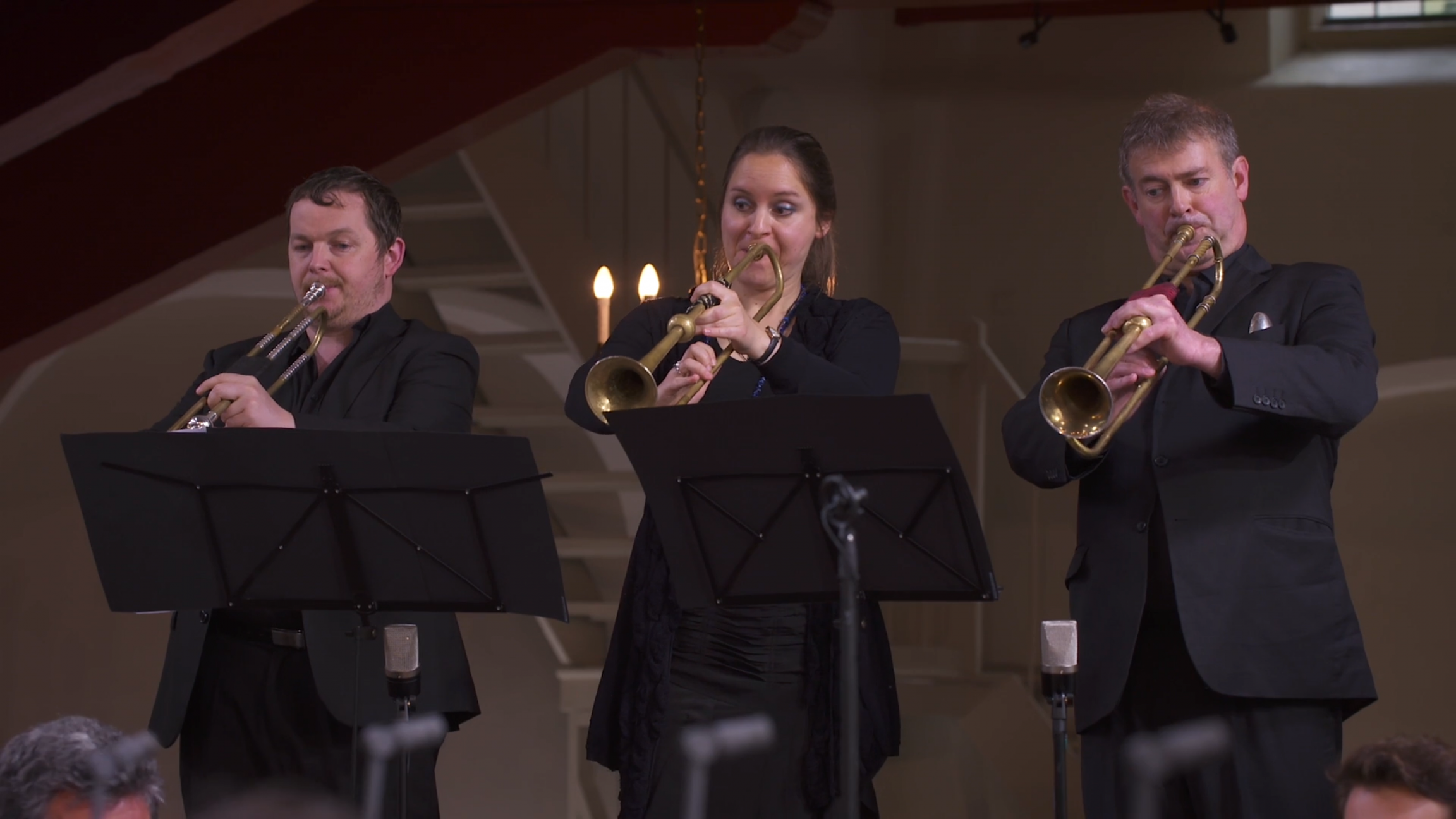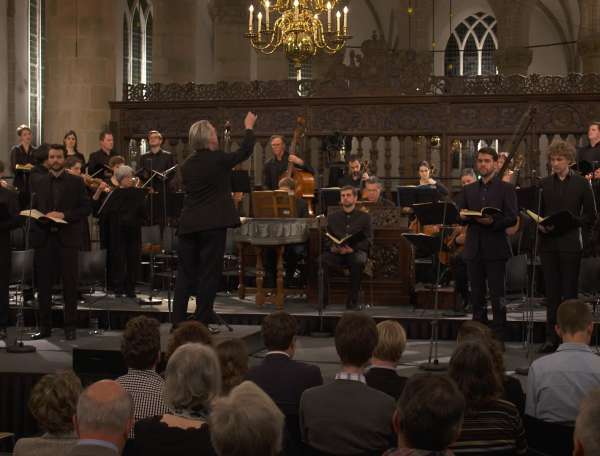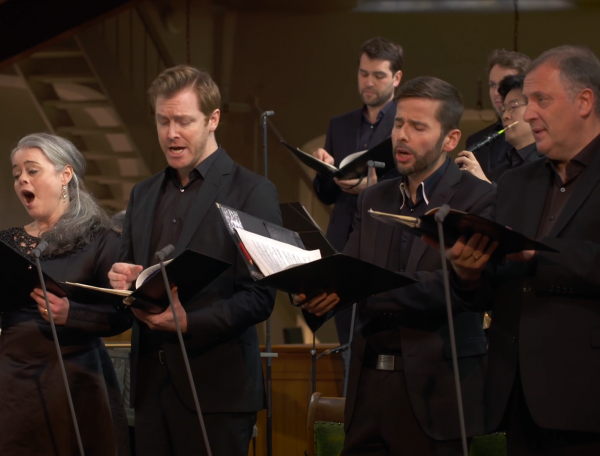

Oster-Oratorium
BWV 249 performed by the Netherlands Bach Society
conducted by Jos van Veldhoven
Walloon Church, Amsterdam
Behind the music
Easter and a birthday
Four biblical characters make their entrance, almost like a Passion Play
This Oster-Oratorium (Easter oratorio) was first performed on Easter Sunday in 1725. Two days earlier, the congregation in Leipzig had listened to the St John Passion, just as in 1724. The closing chorus ‘Ruht wohl, ihr heiligen Gebeine’ sent them on their way home to celebrate Holy Saturday. And then, on Sunday morning, the church resounded with the huge contrast of a Sinfonia with leading roles for three trumpets and timpani. Before the singers get going, Bach seems to recall Jesus’s death with a melancholy Adagio in B minor for solo oboe and strings. This may originally have been the slow middle movement of a lost instrumental concerto. When Bach performed the oratorio again a few years before his death, the oboe solo was played by a transverse flute, just as in this performance.
In Bach’s church music, this Easter oratorio is an exceptional work in the sense that the recitatives and arias are sung by four biblical characters, almost like a Passion Play. They are Mary Magdalene, Mary Jacobe, Simon Peter and John the Apostle. The two men are hurrying towards the tomb of Jesus, where they meet the two women and rejoice together at the resurrection of Jesus. As the protagonists form a model quartet (soprano, alto, tenor and bass), it is to be expected that the four-part closing chorus is also sung by only these four singers.
The first vocal section, ‘Kommt eilet und laufet’, was originally a duet for tenor and bass. So they are really Simon Peter and John the Apostle, who are hurrying to the Holy Sepulchre. For the aforementioned revival near the end of his life, Bach was to rework this opening duet as a four-part ‘chorus’, whereby the middle section was kept as a duet for tenor and bass.
The Oster-Oratorium also has a secular counterpart, the birthday cantata Entfliehet, verschwindet, entweichet, ihr Sorgen, composed by Bach for Duke Christian von Sachsen-Weißenfels in February 1725, just weeks before the first performance of the sacred version. Here, the characters are the four shepherds coming to congratulate the duke. The words of this birthday cantata were written by Bach’s favourite librettist, Christian Friedrich Henrici, alias Picander. It is perfectly plausible that he also wrote the words to the Easter music, and delivered them at the same time, so that Bach could simultaneously compose music to serve for both occasions. Of course, the two versions did need different recitatives. In this secular counterpart, the closing section is written as an ‘aria à quartetto’, which confirms the assumption that Bach had the four solo singers in mind here.
- BWV
- 249
- Title
- Kommt, eilet und laufet
- Epithet
- Oster-Oratorium
- Genre
- oratorios and Passions
- Year
- 1725 1732/35 1740/50
- City
- Leipzig
- Lyricist
- unknown, probably Christian Friedrich Henrici (Picander)
- Occasion
- Easter Sunday
- First performance
- 1 April 1725
- Special notes
- There are three versions of this oratorio. The first is a sacred variation on the lost secular cantata Entfliehet, verschwindet, entweichet, ihr Sorgen. The first movement probably originated from a lost instrumental concerto.
Vocal texts
Original
1. Sinfonia
2. Adagio
3. Chor
Kommt, eilet und laufet,
ihr flüchtigen Füsse,
erreichet die Höhle,
die Jesum bedeckt!
Lachen und Scherzen
begleitet die Herzen,
denn unser Heil ist auferweckt.
4. Rezitativ (Alt, Sopran, Tenor, Bass)
Maria Magdalena
O kalter Männer Sinn!
Wo ist die Liebe hin,
die ihr dem Heiland schuldig seid?
Maria Jacobi
Ein schwaches Weib muss
euch beschämen!
Petrus
Ach! ein betrübtes Grämen
Johannes
und banges Herzeleid
Petrus, Johannes
hat mit gesalznen Tränen
und wehmutsvollem Sehnen
Ihm eine Salbung zugedacht,
Zwei Maria’s
Die ihr, wie wir,
umsonst gemacht.
5. Arie (Sopran)
Maria Jacobi
Seele, deine Spezereien
sollen nicht mehr Myrrhen sein.
Denn allein
mit dem Lorbeerkranze prangen,
stillt dein ängstliches Verlangen.
6. Rezitativ (Tenor, Bass, Alt)
Petrus
Hier ist die Gruft
Johannes
Und hier der Stein,
der solche zugedeckt;
wo aber wird mein Heiland sein?
Maria Magdalena
Er ist vom Tode auferweckt!
Wir trafen einen Engel an,
der hat uns solches kundgetan.
Petrus
Hier seh ich mit Vergnügen
das Schweisstuch
abgewickelt liegen.
7. Arie (Tenor)
Petrus
Sanfte soll mein Todeskummer
nur ein Schlummer,
Jesu, durch dein Schweisstuch sein.
Ja, das wird mich dort erfrischen
und die Zähren meiner Pein
von den Wangen tröstlich wischen.
8. Rezitativ (Sopran, Alt)
Zwei Maria’s
Indessen seufzen wir
mit brennender Begier:
Ach, könnt es doch
nur bald geschehen,
den Heiland selbst zu sehen!
9. Arie (Alt)
Maria Magdalena
Saget, saget mir geschwinde,
saget, wo ich Jesum finde,
welchen meine Seele liebt!
Komm doch, komm, umfasse mich,
denn mein Herz ist ohne dich
ganz verwaiset und betrübt.
10. Rezitativ (Bass)
Johannes
Wir sind erfreut,
dass unser Jesus wieder lebt,
und unser Herz,
so erst in Traurigkeit
zerflossen und geschwebt,
vergisst den Schmerz
und sinnt auf Freudenlieder;
denn unser Heiland lebet wieder.
11. Chor
Preis und Dank
Bleibe, Herr, dein Lobgesang.
Höll' und Teufel sind bezwungen,
ihre Pforten sind zerstört;
jauchzet, ihr erlösten Zungen,
dass man es im Himmel hört.
Eröffnet, ihr Himmel,
die prächtigen Bogen,
der Löwe von Juda
kommt siegend gezogen!
Translation
1. Sinfonia
2. Adagio
3. Chorus
Come, hurry and run,
you speedy feet,
reach the cavern
which conceals Jesus!
Laugter and merriment
accompanies our hearts,
since our Savior is risen again.
4. Recitative
Mary Magdalene
O cold hearts of men!
Where has your love gone,
that you owe to the Savior?
Mary Jacobi
A weak woman must put
you to shame!
Peter
Alas, a troubled grieving
John
and anxious heartache
Peter, John
along with salty tears
and woeful longing
were intended as a salve for him.
Mary Jacobi, Mary Magdalene
Which you, like us,
prepared in vain.
5. Aria
Mary Jacobi
O soul, your spices
need no longer be myrrh.
For only
crowning with the laurel wreath
will quiet your anxious longing.
6. Recitative
Peter
Here is the grave
John
and here the stone
which sealed it.
Where, however, can my Savior be?
Mary Magdalene
He is risen from the dead!
We encountered an angel
who gave us these tidings.
Peter
Here I behold, with pleasure,
his shroud
lying tossed aside.
7. Aria
Petrus
Gentle shall my death-throes be,
only a slumber,
Jesus, because of your shroud.
Indeed, it will refresh me there,
and the tears of my suffering
it will tenderly wipe from my cheeks.
8. Recitative
Mary Jacobi, Mary Magdalene
Meanwhile we sigh
with burning desire:
Ah, could it only
happen soon,
to see the Savior ourselves!
9. Aria
Mary Magdalene
Tell me, tell me quickly,
say where I can find Jesus,
whom my soul loves!
O come, come, embrace me;
for without you my heart is
completely orphaned and wretched.
10. Recitative
John
We are delighted
that our Jesus lives again,
and our hearts,
which first dissolved
and floated in grief,
forget the pain
and imagine songs of joy;
for our Savior lives again.
11. Chorus
Praise and thanks
remain, Lord, your hymn of praise.
Hell and devil are conquered,
its gates are destroyed.
Rejoice, you rescued tongues,
so that you are heard in heaven.
Open, O heavens,
your magnificent drawbridges,
the Lion of Judah
approaches in triumph!
translation © Pamela Dellal
Credits
-
- Release date
- 21 April 2019
-
- Recording date
- 13 May 2017
-
- Location
- Walloon Church, Amsterdam
-
- Conductor
- Jos van Veldhoven
-
- Soprano
- Maria Keohane
-
- Alto
- Damien Guillon
-
- Tenor
- Thomas Hobbs
-
- Bas
- Sebastian Myrus
-
- Ripieno soprano
- Marjon Strijk, Kristen Witmer
-
- Ripieno alto
- Marleene Goldstein, Barnabás Hegyi
-
- Ripieno tenor
- Yves Van Handenhove, David Lee
-
- Ripieno bass
- Drew Santini, Matthew Baker
-
- Violin 1
- Shunske Sato, Anneke van Haaften, Annelies van der Vegt
-
- Violin 2
- Sayuri Yamagata, Pieter Affourtit, Paulien Kostense
-
- Viola
- Staas Swierstra, Jan Willem Vis
-
- Cello
- Lucia Swarts, Richte van der Meer
-
- Double bass
- Hen Goldsobel
-
- Traverso
- Marten Root, Doretthe Janssens
-
- Oboe
- Martin Stadler, Peter Frankenberg
-
- Recorder
- Benny Aghassi, Martin Stadler
-
- Bassoon
- Benny Aghassi
-
- Trumpet
- Robert Vanryne, Fruzsina Hara, Mark Geelen
-
- Timpani
- Robert Kendell
-
- Organ
- Leo van Doeselaar
-
- Harpsichord
- Siebe Henstra
-
- Director and editor
- Bas Wielenga
-
- Music recording
- Guido Tichelman, Bastiaan Kuijt, Pim van der Lee
-
- Music edit and mix
- Guido Tichelman
-
- Camera
- Jochem Timmerman, Thijs Struick, Martin Struijf
-
- Lights
- Zen Bloot, Henry Rodgers, Patrick Galvin
-
- Assistant director
- Ferenc Soeteman
-
- Video engineer
- Robert-Jan Neijland
-
- Set technique
- Justin Mutsaers
-
- Data handling
- Jesper Blok
-
- Project manager nep
- Peter Ribbens
-
- Interview
- Onno van Ameijde, Marloes Biermans
-
- Producer concert
- Marco Meijdam, Imke Deters
-
- Producer film
- Jessie Verbrugh
Discover
Help us to complete All of Bach
There are still many recordings to be made before the whole of Bach’s oeuvre is online. And we can’t complete the task without the financial support of our patrons. Please help us to complete the musical heritage of Bach, by supporting us with a donation!

